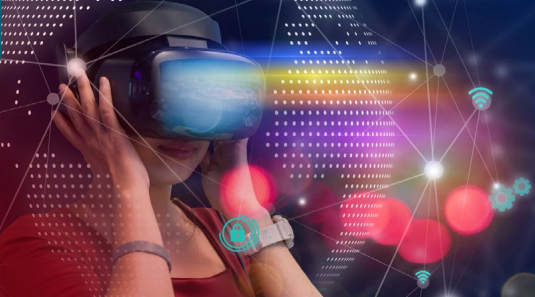Investing in the Metaverse: Opportunities in the platform’s next frontier

Human social interactions are on the verge of the next major evolution as we enter the age of the metaverse.
The metaverse provides humans with access to a digital platform in parallel with our physical reality. The internet as we know it has the potential to evolve into a shared platform with immersive virtual worlds where people interact with each other in real-time and can create landscapes and real world objects. The metaverse promises to be at the forefront of the fourth industrial revolution.
It is important to note that the majority of metaverse projects are being spearheaded by the gaming industry. The virtual worlds developed in modern computer games mimic our physical reality, from asset ownership and trade, to facilitating social interactions and creating communities.
In order to navigate the uncertainty of the metaverse, JP Morgan investment bank, through Project Onyx, published a report in January 2022. The report speculates on the potential business opportunities to invest and capitalise on the internet’s next frontier, through an effective metaverse strategy.
The report sought to distinguish the current internet model (web 2.0) from the metaverse (3.0).
Platform characteristics
The organisational structure of internet platforms is going to shift significantly from centrally owned entities to community governed networks. The community governing model generally adopts the form of a decentralized anonymous organization (DAO). A DAO’s financial transactions and rules are recorded on a blockchain. This eliminates the need to involve a third party in a financial transaction, simplifying those transactions through smart contracts. In addition, native tokens are issued and enable participation in governance, furthering the possibility of decisions based on user consensus.
Platform format – Considering the metaverse shall consist of augmented 3D virtual worlds, traditional technology, e.g. mobi used to access and interact with web 2.0 will become redundant. Tech manufacturing companies should begin to invest in developing platforms that can support the metaverse as well as the human-computer interaction hardware that users will require to access the metaverse. These include PCs with greater processing power and Virtual Reality consoles.
User interaction
Currently, digital assets bought in the web 2.0 are generally restricted to the platform they are purchased on. However, with the development of cross platform interoperable assets and tokens such as cryptocurrencies and non-fungible tokens (NFTs), digital assets ownership and portability will be revolutionised.
Content creators – Currently, it is the game and application developers that dictate the content that users interact with in the web 2.0, Within the metaverse, community members interacting and using the web 3.0 technologies will play an active role in creating the virtual environment that they interact within.
Commercial structure
Payments infrastructure – The report states that the use of traditional payment systems for web 2.0 technologies and online platforms such as credit or debit cards will be replaced with tradeable crypto currencies, and potentially even the use of central bank digital currencies (CBDCs).
Content revenues – Traditionally, content revenues for applications or games are shared between the platform developer and the app store or marketplace for the application. The metaverse will enable more peer-to-peer transactions, enabling developers (content creators) to directly earn revenue from sales. Furthermore, it is anticipated that the content creators can benefit from the royalties on secondary trades of NFTs and other digital assets.
Investment Opportunities
The emergence of virtual reality platforms offers corporations, technology providers and financial institutions numerous opportunities to collaborate and develop the solutions that will drive the metaverse and the fourth industrial revolution.
Below are the report’s highlights on the potential investment and business opportunities to spur the development of the metaverse:
Technology
With metaverse technology in its infancy, there is a need to enhance the current capabilities and efficiency of our technology in order to realise the potential of the metaverse. This includes:
- Improved performance in avatar movement and environment rendering;
- Development of interoperability or cross-virtual world interactions, and ways to manage engagement and digital assets across these platforms; and
- Definition of standards for digital assets (wearables, objects, brands) and virtual/ cryptocurrencies, so they can be transferable across various virtual worlds (with potentially different manifestations in each world, e.g., the same NFT manifests as a special edition t-shirt in a virtual world but is a uniquely designed vehicle in a race car video game).
Commercial infrastructure
The commercial infrastructure is due significant overhaul, as emerging payment solutions need to be enhanced and scaled up. The opportunities include:
- Develop a single wallet user experience, inclusive of:
- Web 2.0 traditional finance payment rails, virtual currencies and virtual assets;
- Web 3.0 crypto, NFTs and digital assets;
- Digital identity verifiable credentials, know your customer (KYC)/anti-money laundering (AML) compliance keys, and reputation points; and
- Evolution of virtual/cryptocurrencies and digital asset backed financing and mortgages through using lending models, or leveraging decentralised finance (e.g., NFT-collateral backed virtual world mortgages);
- Creation of cross-border and cross-metaverse foreign exchange and liquidity solutions; and
- Expansion of solutions and services to support DAO community-based projects, business ventures and investments.
Workforce of the future
The evolution of the online platforms shall require a workforce with new skillsets and competencies. Organisations can begin to pre-empt changes to the workforce requirements by:
- Training new designers and developers with specialisation in 3D modelling of avatars, wearables, objects, architecture and interiors, leveraging virtual world-specific software development kits (SDKs);
- Evolution of content creators and storytellers that can span across virtual worlds, virtual goods, NFTs, token gates, (varying manifestations of NFTs across platforms), commerce and communities;
- Redeployment of event producers that specialise in metaverse experiences (concerts, parties, art showings, community meetings, sports events, sightseeing and travel); and
- Creation of community managers focused on creating robust online and offline relationship-building and interactions to strengthen platform engagement.

